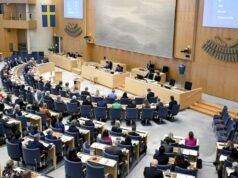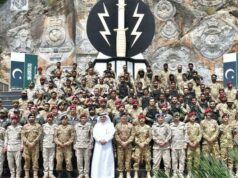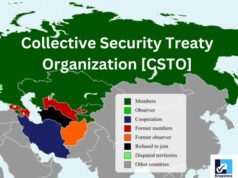For A Synchronized Foreign And Defence Initiative The Defence Secretary Needs To Be An IFS Officer

By
Colonel Awadhesh Kumar, Veteran Special Forces
Talk softly but carry a big stick. Well you can talk softly with all and sundry only if you do have a big stick and you are ready and prepared to use it when required. This dictum is applicable at all levels, from individuals to nations.
The military is that big stick or the most powerful instrument for advancing national interest. Nearly all major powers while interacting with other countries diplomatically have a proper integrated military policy in the background.
In India, the mechanism to use the Diplomatic Posture in conjunction with the powerful military instrument with proper institutionalized synchronization has simply been missing. Even after building up a powerful and large defence forces and a credible triad nuclear deterrent with established missile and tested anti satellite capability, somehow over the years India kept lagging in this field. We adapted reactive policies and never tried to apply our military soft power diplomatically.
In fact till some time back even our higher defence management organization itself was functioning in most uncoordinated manner.
Even the functional relationship between the service headquarters and the ministry of defence was most unsatisfactory. What to talk of proper coordination between the Ministry of Defence and the Ministry of External Affairs, even the coordination between the ministry of defence and the Services HQ was virtually in shambles.
Well all this was not surprising when the main plank of our International posture since early 1950s got based on Panchsheel Principles. After all, the overall perception was that we got “Azadi bina khadak bina dhal “. Indian diplomacy traditionally remained non-military in character but the Governmental actions on ground looked different.
In 1948, resolute military action was taken in Hyderabad, Junagadh and even J&K but non coordination somewhere led to accepting Ceasefire at the wrong time. In 1961, Western World was shocked when Indian Forces once again resolutely marched in to liberate Goa, Daman and Diu but similar planned and coordinated diplomatic offensive against Portuguese brutal rule was missing. We and Tibetans both paid badly for this lack of coordinated action in Tibet against Chinese move right from 1954 onwards and finally India itself had to face tremendous military and diplomatic set back in 1962.
In spite of all this, the military hammering given to the Chinese Forces in 1967 in Sikkim was never highlighted to the world through a diplomatic offensive. Same thing happened in 1965 when militarily we crossed the IB in Punjab and Jammu to ease pressure in Akhnoor and rest of J&K. Though later improper coordination between military and diplomacy led to giving up on all our gains.
Though in contrast things were superbly coordinated right from word go during the preparation and then during the conduct of 1971 War. Surprisingly due to lack of institutionalized arrangements, within no time, as usual, all gains went down the drain at Shimla. Forget all others things, in return of 90000 prisoners of war, we never asked for return of even our now “forgotten 54 “ Indian Prisoners of War in Pakistan.
Things seemed to get on proper tracks during the Kargil episode. Well now we have had a HQ IDS for many years and now finally a Chief of Defence Staff and even a Department of Military Affairs within the Ministry of Defence. Hopefully now onwards things should improve.
Defence ministers, External Affairs Minister and service chiefs have begun visiting other countries in a somewhat coordinated manner and even engaging USA, Russia and countries like Iran at the same time in what have been labeled as 2+2 or 1+1 dialogues. The Ministers from USA both State and Defence were in India for talks and at the same time Iran Trade Minister was here for talks !! This is what is needed.
The surgical strike in Myanmar against the Naga insurgents after they bombed a military convoy in Manipur was a sound message and has resulted in a peace accord. A similar strike after Uri did give a message but got diluted by the internal tukde tukde gang. However Balakot strike was a very clear message “ acknowledged “ not only by Pakistan but internationally, in spite of all the yapping questioning it.
The corps of military attachés in our missions abroad are being expanded in a planned manner to work for improving defence cooperation and defence trade with the targeted countries in conjunction with our diplomatic advancements.
Vacancies On Courses to Other countries in our Military Training Establishments have been increased due to their popularity. Apart from our National Defence College course going on foreign military tours,even Higher Command Courses and others have started going on such tours to interact with military and diplomats of other countries at governmental level.
What to talk of official visits, last year in July, more than 50 retired officers and their wives of 52 NDA Course were given a warm welcome at the Singapore Military Academy during a Course get together ….. courtesy two retired officers of Singapore Army / Air Force who had also been part of 52 NDA. Air Chief Marshal Dhanoa and General Rawat would have been part of the course get together but at that time both were still serving. No wonder sizeable contingents of Singapore Army and Air Force come for their training to places like Babina, Ahmednagar and ……on regular basis every year.
Recently speaking on the threats in the Indian Ocean and the Indo-Pacific region Raksha Mantri said, “We need to be more focused to secure our interests. We have adopted pro-active measures to promote peace and stability in the region as well as to increase defence and security cooperation with the Indian ocean rim countries so as to create a stable maritime environment.”
The military has been actively engaging other militaries in conducting joint military exercises. We exercises on regular basis with a number of countries which includes USA, Russia, France and Vietnam. The annual Malabar exercise with the US has become trilateral with Japan joining in and set to become a quad with Australia eager to join in.
Effectiveness of Malabar Exercise has been noted with trepidation by China even when India has no intention of forming military alliances against any country. India also conducts naval exercise with other countries such as Russia, France, the United Kingdom, Sri Lanka, Australia, Vietnam, the Philippines, New Zealand, South Korea and others.
In February this year, India and Oman agreed on providing facilities for Indian military vessels at Duqm port. The maiden India-United Arab Emirates naval exercise was held in March this year.
India and Indonesia have agreed to boost defence and maritime cooperation, including regular bilateral naval exercises, with plans to develop a strategic Indonesian naval port at Sabang, very near to INDIRA POINT, the last tip of Indian land mass in Nicobar.
Since 1995, the Indian navy conducts the biennial Milan exercise with navies of the Indian Ocean region in the Andaman and Nicobar Islands area. The Indian Ocean Naval Symposium commenced in 2008 as a forum for all the littoral nations of the Indian Ocean to participate on regional security. The Indian Air Force, too, is active in participation in joint exercises with countries like Russia, the UK, France and the US. The army conducts exercises with the US, Sri Lanka, Nepal and even China.
We have well established military-to-military cooperation with about 18 African countries, with Indian Military training teams based on permanent basis in many countries like Botswana, Zambia, Lesotho and Seychelles. India is one of the largest contributors to UN Peace Keeping in Africa, with forces located in the Democratic Republic of Congo, South Sudan, Ethiopia and Eritrea.
Presently India is labeled as World’s Second largest importer of Arms in a derisive manner. The bright side of this feature is that since 2014, India has begun leveraging this IMPORT to ensure that both USA and Russia pay attention and listen attentively when India speaks.
France and Israel both have become our solid friends and poor Brexit Britain is trying its level best to draw our attention. Even Australia from down under has become aware of the fact that apart from looking up to Uncle Sam, it will be a good idea to establish “ Bhai Bhai “ relationship with India.
The next major aspect of military diplomacy is to expand the exports of our indigenously manufactured weapon systems. Gone are the days of low key items. Now India is looking at export of OPVs, Dhruv and other helicopters, Tejas fighters, Fast Attack naval Crafts, Frigates, Corvettes, Air Defence and anti tank missiles and also BRAHMOS missiles.
In 2016 India exported military equipment worth over Rs 2000 crores. By the time we achieve the Rs 350trillion economy in the foreseeable future, the percentage of arms export in this should become a noticeable one.
Vietnam, Philippines, Oman are soon going to become our esteemed customers along with existing ones like Guyana, Honduras, Argentina, Uruguay, Belize, Peru, Ecuador, Sri Lanka, Suriname, Mauritius, Bangladesh and Seychelles. We are now even offering lines of credit for defence exports to friendly countries.
Apart from Saudi Arabia, UAE showing close interest in our products, recently we beat many established exporters to win an export order to Armenia. Around over 30 countries are now being targeted for exports and in this our Defence Attaches will play a major role along with the Ambassadors and Consulate Generals.
The recent Lucknow defence expo attracted many foreign manufacturers to come to India as part of Make in India. In this the Military DAs will be playing a major role to garner larger FDIs. Even Public Sector Undertakings (DPSUs) have begun to open offices for liaison in different countries in the Indian Ocean Region.
All the above begs for an institutionalized mechanism. To begin with, we need to post a Joint Secretary level officer from Indian Foreign Service, each in HQ IDS, Department of Military Affairs and Department of Defence in MoD. Similarly Major General/ AVM/ Rear Admiral rank officers from Defence be posted as Joint Secretary in External Affairs Ministry and with our Permanent Representative at UN both in New York and Geneva.
Finally why not appoint the next Defence Secretary also from IFS.to institutionalize things presently in coordination together with CISC of HQ IDS and later with Secretary ( Coordination ) in Department of Military Affairs.



